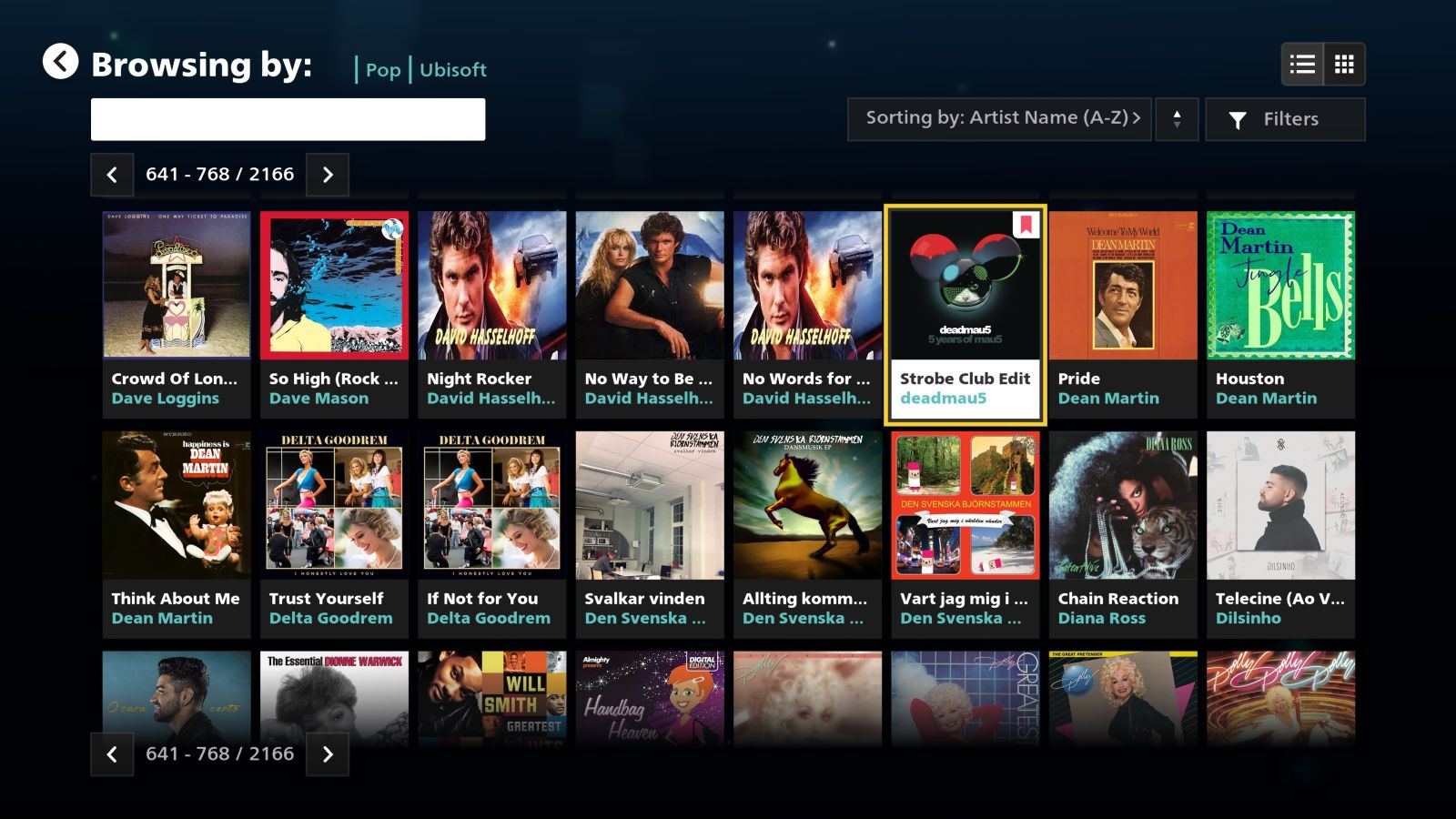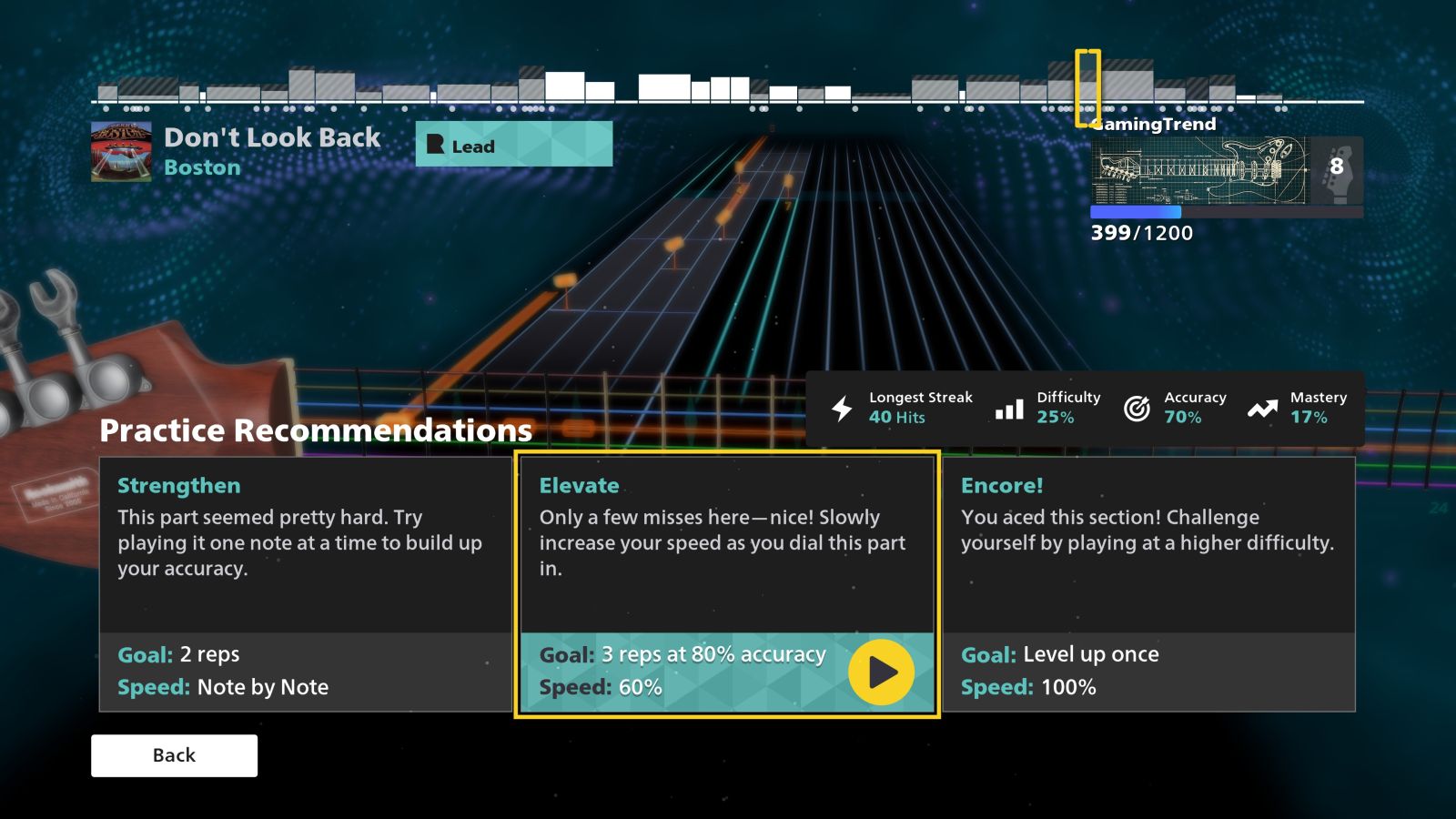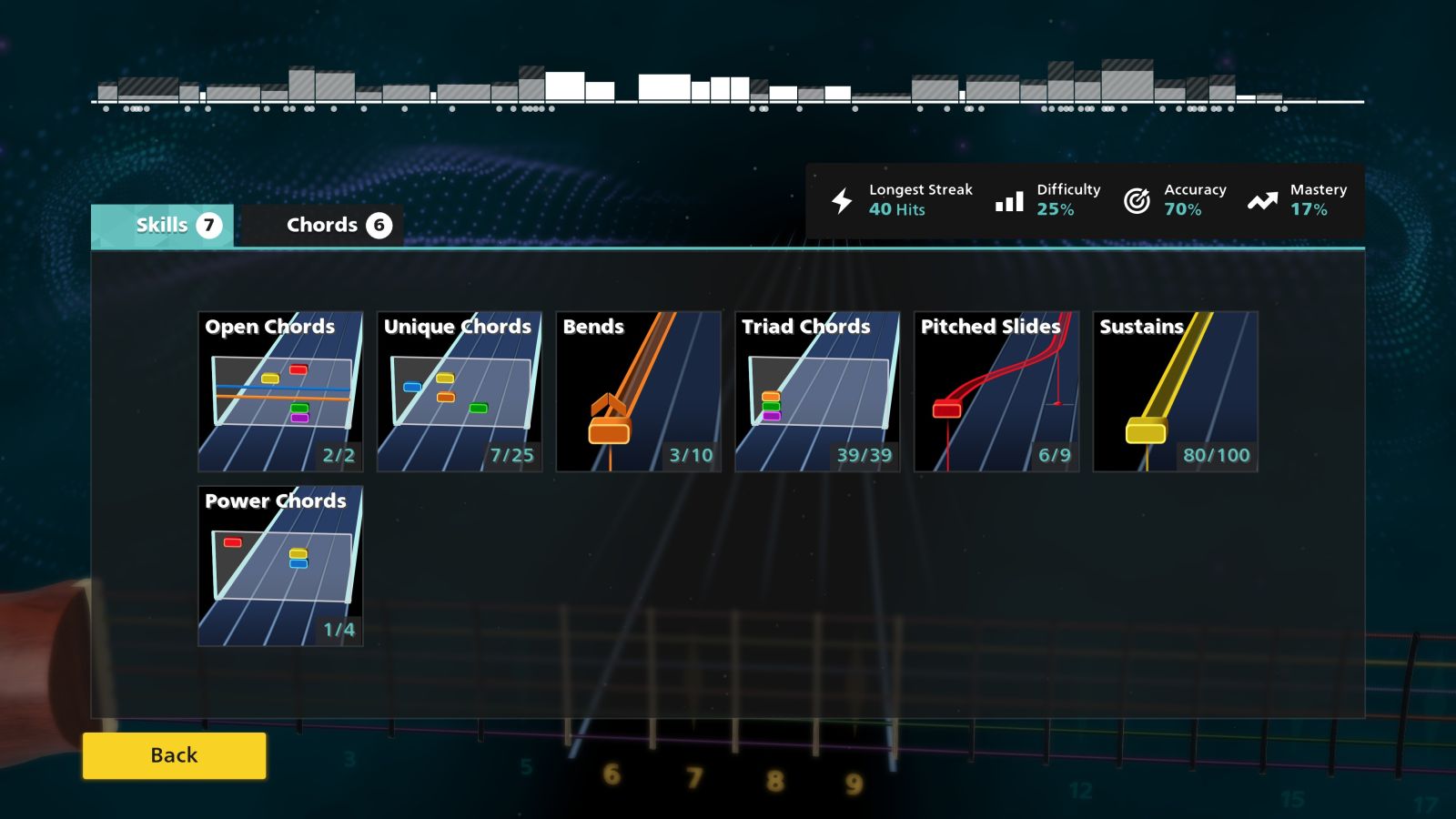
Laura and I have spent a dumb amount of time and money buying tracks to learn to play guitar via Rocksmith. I’m literally playing Rocksmith+ with a pick from the original release of Rocksmith back in October of 2011. To say we are fans of the series is an understatement. While I’ve not suddenly become a master shredder, my wife can routinely crush it on bass, exceeding 100% and watching the notes fade into full obfuscation with her mastery. When Ubisoft announced Rocksmith+, we immediately saw the allure of a subscription service that offered far more content without needing to buy into just what we know. After all, games like Tony Hawk’s Pro Skater are why we know certain bands at all, right? We were eager to jump in and shred to some all-new tracks. It’s time to strap up and rebuild those calluses.
Rocksmith+ has just launched into the first 30 days of its ongoing service, so it’s probably a bit early to cast our full review at this point, therefore we’ll be offering up a hands-on impression, with updates at the 30, 60, and 90 days mark. At that point the game should be fully cemented into its semi-final form, so it’d be fair to judge it at that point. As such, our impressions are anything but sealed in stone.
My first impression of Rocksmith+ was rocky at best. My first two launches of the game resulted in a crash to desktop. Plugging in my RealTone cable yielded zero sound, so it also gave me a plunge into the support pages at Ubisoft to find out that reinstalling the drivers from within Device Manager is a common fix for this problem (it took three reinstalls for mine to finally work, so be persistent!) – I hope that helps somebody reading this. With those out of the way, we could finally get to playing.
In a section entitled “Getting to know you” you’ll set up your gear. First you’ll select the correct instrument – Guitar or Bass, and then the type of headstock you are using. With that out of the way you’ll hit the first major change for Rocksmith+ – the interface. I don’t mean the UI, that’s something else – no, I mean how the game hears what notes you are playing. In Rocksmith+ you can use the Realtone cable from the original games, or you can download and use an app, or any midi interface hardware. The cable, once working, is the most reliable, but the addition of the app or midi hardware is a welcome one. Let’s talk about the app.
Installing the app on Android or iOS effectively gives you a device ready to listen and relay the results to the game. How do you get your sound from A to B? Well, that’s where an amp comes in. Yep, for the first time ever you can use your real amplifier, allowing the application on your smart device to act as your RealTone cable. This should shut up the one idiot still saying “just play real guitar already!” once and for all.
The midi option is still listed as Beta. I don’t have anything handy to test this (midi is my wife’s department and she’s “had enough till they fix this horrible mess”, so we’ll be coming back to this in a future update, hopefully.
With your connection type ready to go, you’ll meet Natasha. Nathasha is effectively your narrator, though you’ll be introduced to plenty more experts along your journey. In this quick video, Natasha will give you an overview of what Rocksmith is, and how it’ll be helping you to learn your craft. After this, the world is your oyster.
There are a ton of things to unpack with Rocksmith+ at this point. You can jump into various tutorials, a segment called “The Inbox” where you can get answers to common questions like “Which pickup should I use?” (something I wondered myself), or “Why is my guitar less accurate at the top of the neck?” (you are pressing too hard!), or even how to properly coil a cable. A Practice section gives you scales practice, with each exercise split by difficulty – easy, intermediate, and advanced. If you are looking for minigames like Scale Warriors, Rocksmith+ has tossed all of those, fully embracing its role as a learning tool, for better or worse.
Tuned and ready, Natasha gives me a quick refresher course on the Rocksmith note chart with a quick rendition of House of the Rising Sun. Everything from here will rely on the AI learning my tastes to parse through 5000+ songs at launch with more on the horizon, but I could at least give it a leg up by selecting from one of the 15 genre choices, with the last being an “Other” catch-all. For reference, you’ll find several tracks from Weird Al under Other, if that’s your jam. With a major category picked, you’ll grab some exemplar tracks to get the AI rolling.
The biggest allure of a games-as-a-service title is the ongoing support. Rocksmith+’s opening salvo is that it ships with over 5000 songs at the time of release. Sit back for a moment and start to think about your favorite songs. Got those in mind? What’s your favorite song from Heart? Doesn’t matter, it’s not here.
What we DO have is an entire page of The Wiggles. Yes, The Wiggles – the children’s show, The Wiggles. THE WIGGLES! This problem persists across the entire catalog as your favorite artists might be represented, but the songs that made them famous most often are not. Every song from Clannad is represented, except for their most famous one, the Theme from Harry’s Game There are more tracks from The Clash than I knew even existed. I’ve never heard of Rogue Traders (they aren’t bad – add one to my new artist list!), but it appears their entire discography is present here. Simple Minds? Not the tracks you are thinking of. There’s one Sade track, and it isn’t Sweetest Taboo – you’ve just broken the heart of every bassist on the planet. Toto has some of the most magnificent guitar tracks ever laid down, but we are stuck with I won’t Hold You Back and How Does it Feel? I figured I’d throw something difficult at the list and hit some way off the beaten path tracks – Bomfunk MC’s Freestyler. Well, turns out, that’s in here, much to my surprise and delight. Ok, how about Rush? Nope, not a single track from the Canadian Trio. Darude is in here…somehow. This library is equally as overstuffed as it is barren. I had written down that there was only one Weird Al track, his Jurassic Park parody, but I just found another one hidden in the “Other” category that didn’t come up when I searched for “Weird Al”. That brings me to the next point – functionality.

I don’t know what to even say…
It’s hard enough to find a track you might like in this list, but the sorting doesn’t work half the time, making it even worse. I’m looking at a screen right now that says it’s sorted by the artist’s name, A-Z, but it’s actually being sorted by song name. Often re-selecting the same sort, or inverting the A-Z sort fixes the issue, but unless nobody in QA has used this since, this bug was present in beta and it’s present at launch. Since there is no on-screen prompt for a keyboard when using a controller, you’ll need to wander over to wherever your keyboard is (unless you are playing seated at your desk I suppose) to attempt to use this completely busted search function.
Metal once again gets the shaft with only 419 songs out of the 5000+, and very few of these being from people you’ve likely heard of in your life. Out of that 419, a full 110 of them are from the band Katatonia – a full quarter of them! My Dying Bride and Opeth make up a sizable chunk of these as well. I guess after all that there was no room for Testament, Iron Maiden, Pantera, Megadeth, Tool, Slipknot, etc. Or maybe they are in another sort spot? Let’s talk about categories.
The categories in Rocksmith+ are Rock, Metal, R&B, Pop, Folk, Jazz, Country, Blues, Latin, Electronic, Reggae, Hip-Hop, New Age, Classical, Regional, and Other. They also don’t work. Looking through Rock you’ll find an overwhelming amount of Latin. Heading into Pop you’ll find…well, even more Latin, as well as such pop bangers as Art Garfunkel’s “Another Lullaby”. Tracks like Strobe Club Edit from deadmau5 are also in Pop instead of Electronic. The disco-electronic infused song Sex by Berlin? Yep, it’s in Pop. This is Cult Jam – yep, it’s in R&B though the entire track is synthesizers. Who can forget renowned R&B star (checks notes) Meat Loaf and his song Stand in the Storm. Put simply, it’s unusable.

Why is this in Pop and not Electronic?
The worst part about every one of these issues above is that they were known in the beta several months ago. Here we are at launch and here those same bugs remain. Did anyone at all look at this? Or did Ubisoft simply choose to ship it regardless? I don’t know which is worse.
When you do finally select a song you’ll be presented with an overview of the track, as well as a choice of what arrangement to play. Arrangements will provide you with options like playing Lead, Rhythm, or “Chord Chart” – a new feature of the game. We’ll get back to that last one, but each of these are rated by difficulty, called out for their tuning, and their creator is credited. You’ll also see the album art, when the song was released and by which artist, and the length. Below all this lies your overall mastery of the song, as well as what skills you’ll learn or reinforce by playing that track. The Rocksmith team promises that they’ll be adding arrangements over time. Let’s talk about those Chord Charts.
Chord Charts are meant to allow you to simply strum along to the chord progression of the song, but this is the equivalent of throwing yourself into the undertow without a vest and an anvil around your leg. The difficulty slider is missing (I imagine the intention was for it to be there, so this could be a bug?) so the game just throws you in with the entirety of the song at full speed.

The search function is straight up broken.
On the flip side of this is easily one of the best improvements I’ve seen come to Rocksmith+ – Chord Explorer. After you’ve finished a track, you can punch in on a specific chord. Not only will the game show you how to play it, and add any more video tips on how to play that chord more effectively, it will also listen while you attempt it. You can play it over and over while the game listens, giving you a checkmark when you’ve got it. This has helped me immensely, and I feel like it’s a fairly hidden feature. Do yourself a favor and find this system and use the snot out of it – it’ll improve your licks immensely.
There’s one thing that Rocksmith+ does very well, and that’s to take advantage of the processing power of the PC. Gone is the sluggish UI and the narrow screens, replaced by 4K and a zippy interface. You aren’t going to be getting a cup of coffee between page loads any longer, and I’m happy to see it. I also appreciated the Health and Wellness section of Rocksmith+. It covers a variety of topics that are important to ensure the end of your play session doesn’t make you feel like you’ve just spent a round in the ring with Mike Tyson. Stretching, posture, conditioning and cooldown are just some of the subjects covered here. The one sorting option that semi-works is the recommendation system as it seems to accurately pick songs by skill level. The game still doesn’t understand my taste in music, but I barely do sometimes, so it’s understandable.
There is one huge improvement that will make a lot of returning amateurs happy. The dynamic difficulty system has been replaced with an adaptive one. This means that the game will introduce smaller elements instead of jumping an entire rung of difficulty mid-song as you climb the technical ladder. This is also kept at the profile level instead of managed at the song level, so you won’t have to “level up” each track individually. With the press of a button, you can also bring up real guitar tablature, which is great for taking the next step in learning your instrument – reading music.

Once you complete a song you’ll be presented with the game’s feedback on your performance. You won’t hear a voice providing you with words of encouragement, but you will see a breakdown of the overall difficulty level, your accuracy, mastery, and your longest streak. If you’ve broken a record in any of these areas, that’ll be shown as well, providing you with the dopamine hit you need to keep practicing. Below this you’ll be prompted to play again, or hit the new Skill Review or Practice sections.
Practice is a blend of Rocksmith and Rocksmith 2014’s systems, offering up the ability to slow down a song, just work on a specific section with Riff Repeater, or even play note by note where the game doesn’t advance until you’ve actually hit the chord or string needed – something returning all the way back from the first game. Practice Recommendations also gives you more nuanced feedback as well. It may tell you that you missed a few bends, suggesting you take the “Elevate” practice session (which you can do right from here), or “Strengthen” which points out specific areas where you really struggled, suggesting you play it one note at a time to build up. It also reinforces what you did well, calling out things like letting you know you’ve aced a specific section and that it’s leveled up, or that you had only a few misses, with suggestions to slow it down and practice this section with an 80% accuracy target over 3 reps. On the notechart you’ll see small dots enumerating where you had misses, so it’s far easier to see where you need practice. This feedback system is absolutely top notch, and I hope the rest of the product and library can match it over time.

Skill Review is where the rubber meets the road for every song you play. All songs start off slow and basic, and you’ll play them a single note at a time. Do well and the game will begin to throw new techniques at you, such as slides, vibrato, tremolo, sustains, palm mutes, hammer-ons and pull-offs, or bends, just to name a few. In the Skill Review section you’ll get a breakdown of those individual elements, as well as a score of how well you executed each one. If you choose, you can pop right over to the Learn section and you’ll find at least two, but often more, lesions on those things. This is an area Ubisoft promises to grow, so we’ll be keeping an eye out. While not in this song feedback section, at the home screen you’ll find a “Guitar Skill Profile”. This also gives you a numeric score of how music you’ve grown with each guitar technique. Clicking on any of these will provide a video for context, as well as linking to the video section that shows you how to execute them.

There is a whole world of being able to utilize Ubisoft’s own ARCHI tool to arrange and submit your own tracks that I have yet to explore, and this could cause the catalog to absolutely explode. What quality checks to ensure that new players aren’t being tossed out of a moving car is yet to be seen, but if the chord tracks I’ve seen thus far are any indication it’s going to be a bumpy ride.
Boiling all this down, I don’t quite know what to make of Rocksmith+. The track list is expansive, but so much of it is B-side or worse. Not having at least the previous song in this massive song list is puzzling at best as it means you will have to keep two copies of the game to play your favorites. There are so many artists I know, but they are buried beneath an absolute avalanche of unsorted Latin tracks. Combined with a woefully broken sorting system, it makes practice an absolute chore. That said, when you DO finally find a track worth playing, the game is absolutely fantastic. The tools wrapped around every aspect of the game are fantastic, and stand head and shoulders above its predecessors. Right now, Rocksmith+ is full of promise, but it’s hard to recommend in its current state. In short (he said without irony at the bottom of 2800 words on the subject), “Needs more practice”.
Look for our update to this review in progress in 30 days as Rocksmith+ continues to evolve.
